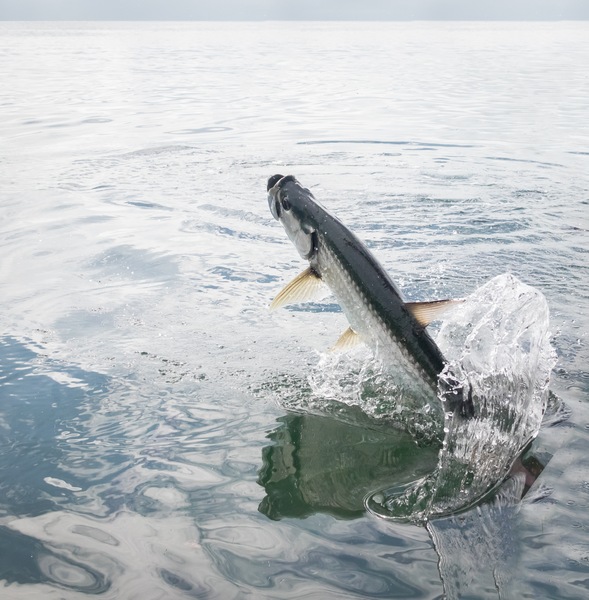Young Boats’ Top Tips for Tarpon Fishing

If you are looking for the most exhilarating experience you will ever have as an angler, then get ready to pack your bags and come to Florida. The Tarpon or Silver King population is abundant, and they are large! Why is Florida the prime location for Tarpon fishing? It is because Florida waters are typically around Tarpon’s ideal water temperature (74-88ºF) year-round. If you have an angling boat from Young Boats and live near the water in Florida, you have the luxury of going Tarpon fishing year-round. Make sure to check the time of year and location you plan on exploring. The concentration of them fluctuates depending on water temperatures and the time of year.
What makes tarpon fishing so exhilarating? They have mastered the art of acrobatics when they get hooked. They can jump up to 10 feet out of the water while doing this unique rattling with their gills. People often compare it to an angry diamondback snake.
Key Regulations for Tarpon Fishing in Florida:
Young Boats wants to remind you of the importance of researching the fishing regulations before jumping in your angling boat and beginning your epic fishing adventure.
In Florida, Tarpon is catch and release. The only way to keep one is if you are pursuing an IGFA world record and have purchased a Tarpon tag (around $50). These Tarpon tags are limited to one tag per year, per person.
Another key regulation is Tarpon fishing gear is limited to hook and line only. Now that you know the rules, let’s get into the tips for the catch of a lifetime!
Positioning:
- Natural Bait: It is best to be up current and let your bait drift towards the fish.
- Live Bait: Cast towards your target fish and let the bait sink slowly in front of it.
- Artificial Bait: Same as above varies by type.
Hook Tip:
Make sure to sharpen your hook even if it is brand new. Tarpons have very bony mouths which makes them difficult to hook.
Time of Day:
Tarpons have large eyes and excellent vision. That is why overcast days, after dark, dawn or dusk are the optimal times to hook a Tarpon.
Weather:
If it is windy, you might want to reschedule. When the water gets choppy, larger sand particles are dispersed in the water and irritate the Tarpon.
How to Tie Your Line:
The recommended method is to double the end of your line at about 6 feet with a Bimini Twist and attach about 8’ of 100 lb mono with a swivel. Some others prefer to start with a 3-foot Bimini twist-tied to 5 feet of 80-pound leader with a Bristol knot. They also put a short piece of 90-pound fluorocarbon between the mono and the circle hook. If you have tried both, we would love to hear your favorite method in the comments below.
Best Bait Options:
- Live Bait: Shrimp, Crab, Pilchards, Mullet, and Pinfish.
- Artificial Lures: Gator spoons 3oz, Mirrolure 65M or 77M in colors 18 or 21, Rapala Magnum in natural colors if trolling, and plastic worms (red, black, or green).
How to Hook a Tarpon:
Setting the hook can be tricky. Keep your rod tip close to the water, secure the end of the rod against your abdomen. Then quickly rotate your body, making the rod move sideways. The most common mistake is to use a Trout setting because you can strike it right out of the Tarpon’s mouth. It is best to be patient and strike at the right time.
- Natural Bait: Wait until you feel the initial bite. Take in the slackline and wait until you feel the weight of the Tarpon and strike hard two times. It is better to wait for natural bait because it ensures the bait is all the way in the Tarpon’s mouth.
- Artificial Bait: If you are using a hard lure, it is the same as natural bait but strike as soon as you feel the fish’s weight at the end of the line.
- Fly Fishing: Do not strike as soon as the Tarpon eats the fly. Only strike once you feel their weight.
How to Reel Tarpon In:
Now that you have officially hooked a Tarpon, get ready for the acrobatics mentioned above. The two key components to worry about now are slack and drag. Lower your rod tip and push it towards the fish and away from the angling boat to increase slack then press on the line to help increase drag. You will know when the Tarpon gets tired because it will typically roll on its side.
How to Properly Handle this Gentle Giant:
Despite being large and bony, they are fragile. Do not lift them by the lip gaff because this can injure them severely. Since they are catch and release it is not recommended to take them out of the water and onto your angling boat. It is best to have someone help hold the Tarpon while you remove the hook.
Young Boats is here to help!
If you are looking for the perfect boat to go Tarpon fishing in Florida, give Young Boats a call! They are your one-stop shop for angling boats, offshore fishing boats, fishing boat restoration, inshore fishing boats, and custom fishing boats.
